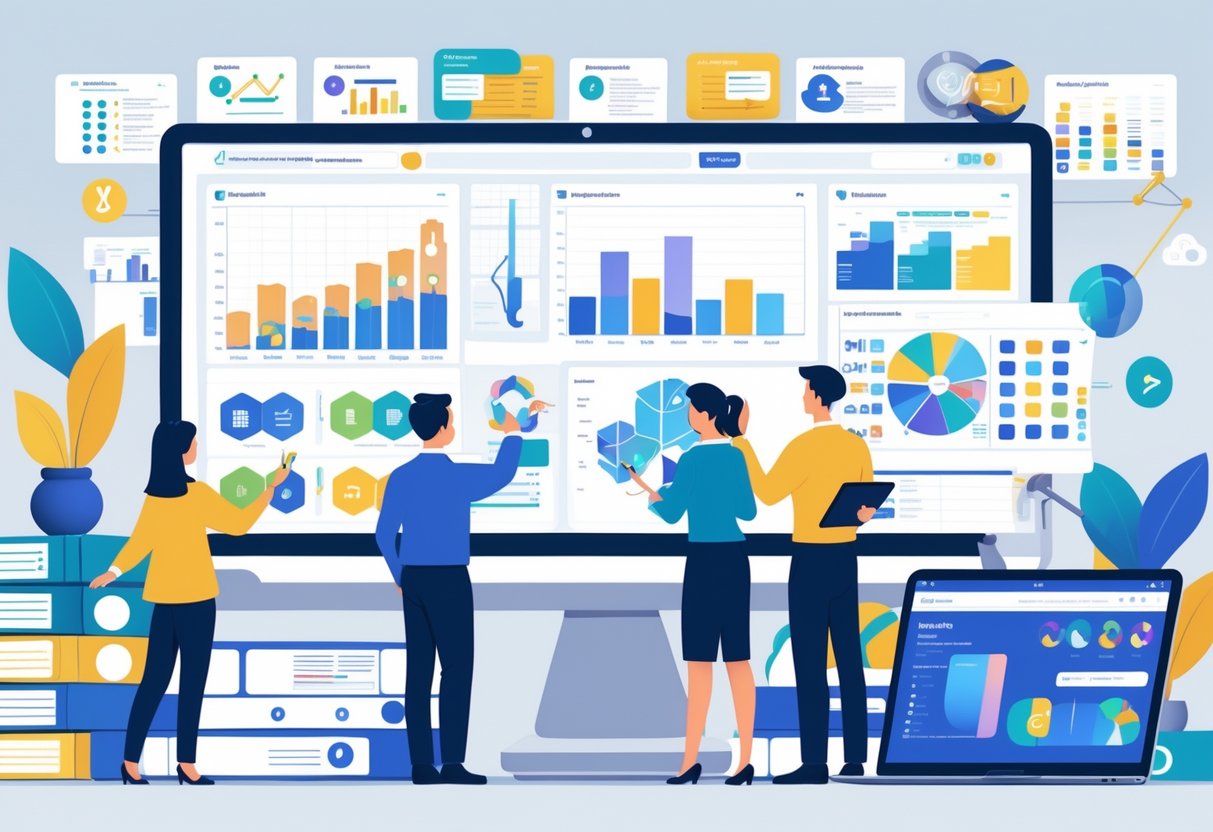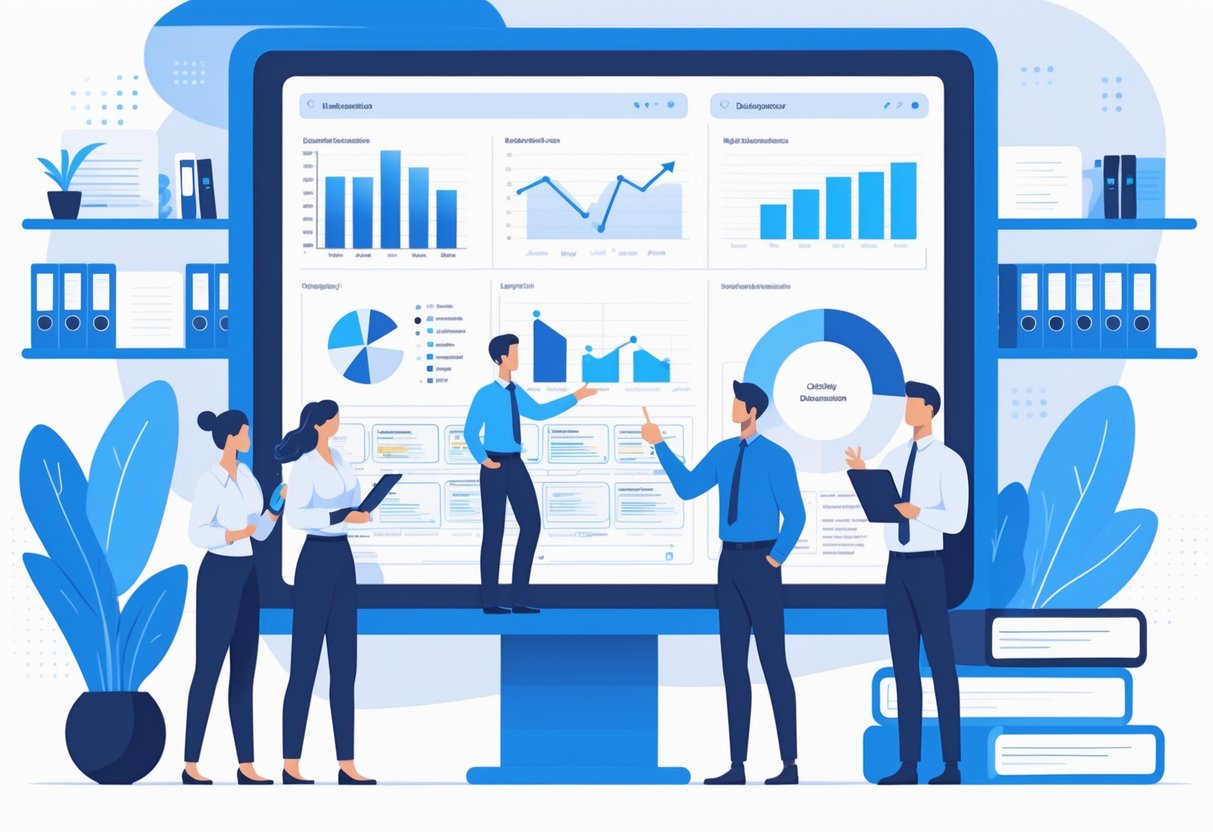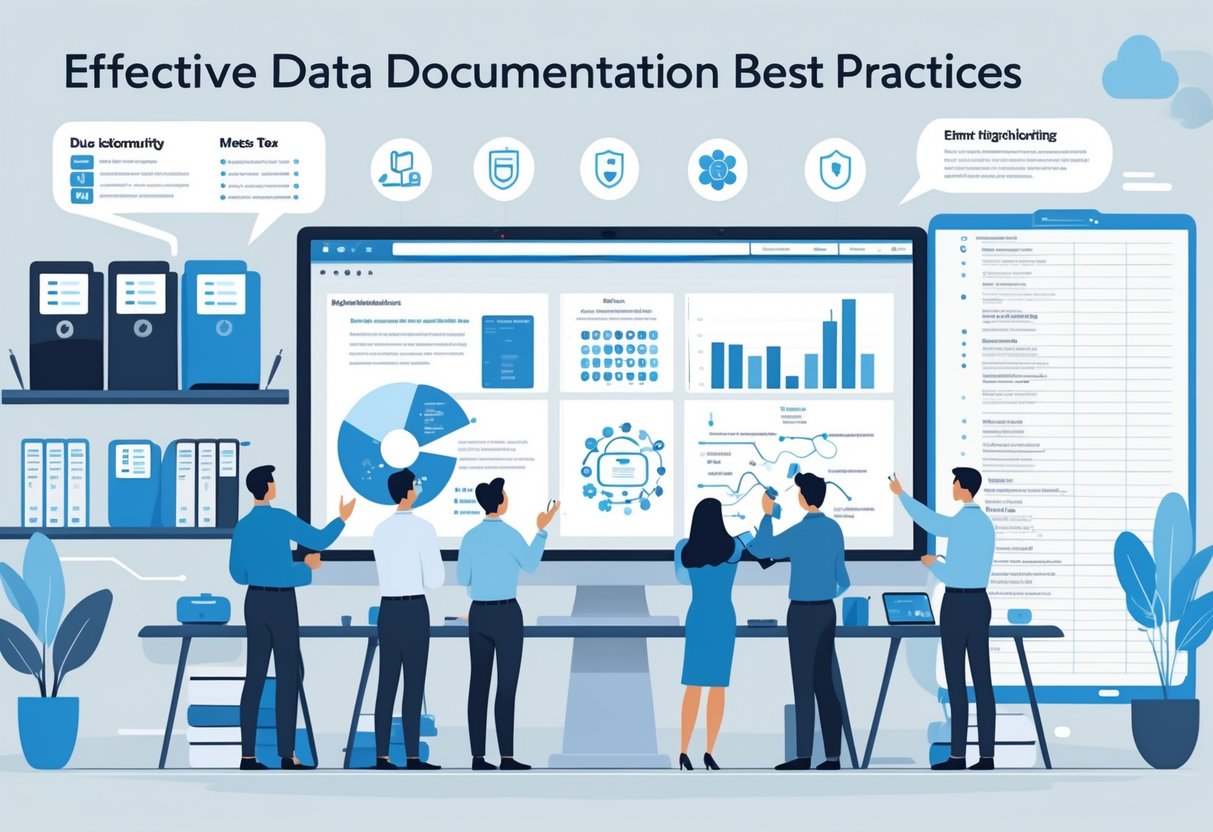Data documentation serves as the foundation for effective data management and helps organizations unlock the full potential of their information assets. Without proper documentation, even the most valuable datasets become difficult to understand, trust, and use effectively across teams and projects.

Good data documentation practices enable teams to find, understand, and trust their data while reducing errors and improving collaboration across the organization. Data documentation and metadata management ensures that critical information about datasets remains accessible and actionable over time. Organizations that implement structured documentation approaches can avoid costly mistakes and duplicate work while accelerating their data-driven decision making.
This comprehensive guide covers the essential elements needed to build robust documentation systems, from establishing clear processes to selecting the right tools and platforms. Readers will learn how to create sustainable documentation workflows that evolve with their data needs while maintaining accuracy and accessibility for all stakeholders.
Key Takeaways
- Effective data documentation requires systematic processes that capture metadata, data definitions, and contextual information consistently
- Organizations should leverage specialized tools and platforms to centralize and manage their data documentation efficiently
- Documentation must be treated as an ongoing process that evolves with changing data requirements rather than a one-time activity
The Importance of Data Documentation

Data documentation serves as the foundation for reliable data management across organizations. It maintains data quality through clear definitions, supports regulatory compliance through proper record-keeping, and enables teams to work together effectively by sharing knowledge about data assets.
Enhancing Data Quality and Integrity
Proper documentation establishes clear standards for data collection and processing. When teams document data sources, transformation rules, and validation checks, they create a framework that prevents errors and inconsistencies.
Data documentation ensures transparency, reproducibility, and usability by providing context about how data was collected and processed. This transparency allows analysts to verify calculations and identify potential issues before they impact business decisions.
Documentation includes several key elements that protect data integrity:
- Data dictionaries that define field meanings and acceptable values
- Process documentation that explains transformation steps
- Validation rules that specify quality requirements
- Change logs that track modifications over time
Organizations with comprehensive documentation report fewer data quality issues. Teams can quickly identify when data doesn’t match expected patterns or when calculations produce unexpected results.
The documentation also helps prevent data misinterpretation. Clear definitions ensure that different teams understand metrics the same way, reducing conflicts and errors in reporting.
Supporting Data Governance and Compliance
Data governance and compliance require detailed records of data handling practices. Documentation provides the evidence needed to demonstrate compliance with regulations like GDPR, HIPAA, and industry-specific standards.
Compliance documentation typically includes:
| Documentation Type | Compliance Purpose |
|---|---|
| Data lineage | Shows data flow and transformations |
| Access logs | Tracks who accessed what data |
| Retention policies | Documents how long data is kept |
| Privacy controls | Records data protection measures |
Efficient documentation practices simplify compliance by creating audit trails that regulators can easily review. Companies with proper documentation can respond to compliance requests faster and with greater confidence.
Data governance policies become enforceable when they are clearly documented. Teams know exactly what procedures to follow for data collection, storage, and sharing when policies are written down and accessible.
Improving Collaboration and Knowledge Transfer
Documentation breaks down knowledge silos that often develop around data systems. When one person leaves a team, their understanding of data structures and business rules stays with the organization through proper documentation.
Onboarding new team members becomes much faster with comprehensive documentation. New hires can understand existing data assets without requiring extensive training from colleagues.
Cross-team collaboration improves when everyone has access to the same information about data definitions and usage. Marketing teams can work with finance teams more effectively when both understand how customer metrics are calculated.
Documentation also enables data reuse across projects. Teams can find existing datasets that meet their needs instead of creating duplicate data collection efforts.
Knowledge transfer happens naturally when documentation captures the reasoning behind data decisions. Future team members understand not just what was done, but why specific approaches were chosen for different data challenges.
Key Elements of Effective Data Documentation

Successful data documentation requires three core components that work together to create a complete picture of your data assets. These elements include detailed metadata and dictionaries, clear structural documentation, and comprehensive records of data origins and processing steps.
Metadata and Data Dictionaries
Metadata serves as the foundation of all data documentation efforts. It provides essential context about data creation dates, ownership, update frequency, and quality metrics that users need to evaluate data reliability.
Data dictionaries function as centralized repositories that define every data element within your datasets. They should include field names, data types, valid value ranges, and business definitions for each column.
Essential metadata components include:
- Data owner and contact information
- Creation and last modified dates
- Data refresh schedules
- Quality scores and validation rules
- Access permissions and restrictions
Business glossaries complement technical dictionaries by translating technical terms into language that non-technical stakeholders can understand. This dual approach ensures both technical teams and business users can work effectively with the same data assets.
Documenting Data Structure and Models
Data structure documentation explains how information is organized within databases, tables, and files. This includes entity relationship diagrams, table schemas, and field hierarchies that show connections between different data elements.
Data models require detailed documentation of business rules, constraints, and relationships. Teams should document primary keys, foreign keys, and any derived fields that depend on calculations or transformations.
Key structural elements to document:
- Table relationships and joins
- Index definitions and performance considerations
- Data types and field lengths
- Null value policies
- Unique constraints and business rules
Visual diagrams help users understand complex data relationships quickly. These should be updated whenever structural changes occur to maintain accuracy and usefulness.
Describing Data Sources and Transformation Processes
Data lineage documentation tracks how information flows from original sources through various transformation steps to final destinations. This creates transparency about data origins and processing logic.
Transformation processes need clear documentation of every step that modifies, filters, or combines data. This includes SQL queries, ETL scripts, and any business logic applied during processing.
Critical transformation details include:
- Source system connections and extraction methods
- Data cleaning and validation steps
- Aggregation and calculation formulas
- Error handling and data quality checks
- Output destinations and formats
Documentation should explain why specific transformations were chosen and what business problems they solve. This context helps future users understand the purpose behind complex processing steps and make informed decisions about data usage.
Establishing Robust Data Documentation Processes

Strong documentation processes require clear procedures, systematic version tracking, and quality checks through review systems. These elements work together to ensure data remains accurate and accessible across teams.
Developing Standard Operating Procedures
Standard operating procedures create consistency in how teams document their data assets. Organizations need written guidelines that specify exactly what information to capture for each dataset.
The procedures should define required fields like data source, update frequency, and ownership details. Teams must know which metadata management tools to use and how to format their entries.
Documentation templates help maintain uniformity across different departments. These templates should include:
- Data description: Purpose and business context
- Field definitions: What each column represents
- Data lineage: Where information comes from
- Quality metrics: Accuracy and completeness measures
Training programs ensure all team members understand these procedures. Regular workshops keep everyone updated on changes to documentation standards.
Utilizing Version Control Systems
Version control prevents confusion when multiple people work on the same documentation. Git-based systems track every change made to documentation files over time.
Teams can see who modified what information and when those changes occurred. This creates an audit trail for compliance and troubleshooting purposes.
Branching strategies allow different teams to work on documentation updates simultaneously. The main branch contains the approved version while feature branches hold draft changes.
Key version control practices include:
- Commit messages that explain what changed
- Regular merges to prevent conflicts
- Backup copies of all documentation versions
- Access controls for sensitive data descriptions
Automated workflows can trigger documentation updates when data structures change. This keeps documentation current without manual intervention.
Incorporating Peer Review for Accuracy
Peer review catches errors before incorrect documentation reaches end users. A second person validates that descriptions match actual data contents and formats.
Review checklists ensure consistency across different reviewers. These lists cover technical accuracy, completeness, and clarity of explanations.
The review process should happen within 48 hours of documentation submission. Quick turnaround times prevent bottlenecks in data projects.
Reviewers check that field definitions align with business terminology. They verify that data quality documentation includes proper validation rules and error handling procedures.
Feedback loops help documentation authors improve their work. Comments should be specific and actionable rather than vague suggestions.
Leveraging Tools and Platforms for Documentation

Modern documentation requires the right combination of tools to capture, organize, and share data knowledge effectively. The key lies in selecting platforms that integrate well with existing workflows while providing clear visual representation of complex data relationships.
Choosing the Right Data Catalogs
A data catalog serves as the central hub for all data documentation needs. These platforms automatically discover and catalog data assets across an organization’s entire infrastructure.
Key features to evaluate:
- Automatic metadata collection from databases, warehouses, and BI tools
- Data lineage tracking to show how data flows between systems
- Search capabilities that help users quickly find relevant datasets
- Access control to manage who can view sensitive information
Popular options include Apache Atlas for open-source environments and commercial solutions like Collibra or Alation. Data catalog tools integrate directly within existing data stacks, syncing documentation from tools like Snowflake, dbt, and Looker into one location.
Modern data catalogs also support collaborative features. Teams can assign dataset owners, add comments, and tag resources by business domain. This eliminates the back-and-forth communication when someone needs information about a specific dataset.
Using Collaborative Documentation Tools
Collaborative platforms enable teams to create and maintain documentation together in real-time. These tools work best when they integrate with existing development workflows.
Confluence remains a popular choice for technical teams. It allows for structured documentation with templates, version control, and commenting features. Teams can create dedicated spaces for data documentation that link directly to their data catalog.
Wiki-style platforms work well for smaller teams. They offer simple editing interfaces and good search functionality. The key is choosing a platform that team members will actually use consistently.
Integration capabilities matter most. The best collaborative tools connect with code repositories, data catalogs, and BI platforms. This reduces the manual work needed to keep documentation current across multiple systems.
Teams should establish clear ownership models. Each dataset needs a designated maintainer who updates documentation when changes occur.
Integrating Visual Aids for Clarity
Visual elements make complex data relationships easier to understand. Charts and graphs help explain data patterns that text alone cannot convey effectively.
Data lineage diagrams show how information flows from source systems through transformations to final reports. These visual aids help users understand dependencies and potential impact of changes.
Entity relationship diagrams illustrate connections between different data tables. They provide quick reference for analysts building queries or reports.
Modern documentation platforms support embedded visuals directly within text. Teams can include screenshots of dashboard examples, sample query results, or data quality metrics.
Interactive elements enhance user experience. Clickable schema diagrams let users drill down into specific table details. Embedded query examples with copy-paste functionality speed up development work.
The goal is making documentation scannable. Users should quickly identify relevant information without reading lengthy text blocks.
Maintaining and Evolving Data Documentation

Data documentation requires ongoing attention to remain useful and accurate over time. Regular reviews ensure documentation stays current with changing data assets, while strategic alignment keeps documentation efforts focused on organizational priorities.
Reviewing and Updating Data Assets Regularly
Organizations must establish systematic processes for keeping their data documentation current. Data assets change frequently through new sources, modified collection methods, and updated processing steps.
Schedule Regular Reviews
Teams should implement monthly or quarterly documentation reviews. These sessions identify outdated information, missing details, and new documentation needs.
Create a checklist for each review cycle:
- Verify data source accuracy
- Update field definitions
- Check processing step descriptions
- Confirm access permissions
- Validate security classifications
Track Documentation Changes
Effective documentation maintenance requires version control systems. Teams can track who made changes, when updates occurred, and why modifications were necessary.
Use timestamps and change logs for each documentation update. This creates an audit trail that helps teams understand how data assets evolved over time.
Assign Documentation Ownership
Each data asset needs a designated owner responsible for keeping documentation current. Data stewards or subject matter experts typically fill this role.
Aligning Documentation with Data Management Strategies
Documentation efforts must support broader data management objectives. Data documentation strategies should integrate with organizational goals for data governance, quality, and accessibility.
Connect to Business Objectives
Documentation priorities should reflect business needs. Critical data assets supporting key decisions require more detailed documentation than rarely used datasets.
Teams should evaluate documentation investments based on:
- Business impact of the data
- Frequency of data usage
- Regulatory requirements
- Risk levels
Integrate with Data Governance
Documentation standards must align with data governance policies. This ensures consistent approaches across different teams and data assets.
Governance frameworks define documentation requirements for data lineage, quality metrics, and compliance information. Teams can reference these standards when creating or updating documentation.
Support Data Discovery
Well-maintained documentation enables users to find and understand relevant data assets quickly. Search functionality and clear categorization help users locate needed information efficiently.
Frequently Asked Questions

Data documentation requires specific components, templates, and tools to be effective. Common mistakes can undermine documentation quality, while different settings may need different approaches for optimal research outcomes.
What are the key components that should be included in effective data documentation?
Effective data documentation must include data source information and collection methods. This covers where the data came from and how researchers obtained it.
Data descriptions form another essential component. These include variable definitions, data types, and measurement units used throughout the dataset.
Quality assessments document known data issues and limitations. This includes missing values, outliers, and any data cleaning steps performed.
Access information specifies data location and refresh frequency. Data science documentation practices emphasize documenting where data is stored and how often it updates.
Legal compliance details ensure proper data usage. This covers user agreements, privacy requirements, and regulatory compliance status.
How can one create clear and usable data documentation templates for research purposes?
Research templates should start with standard metadata fields. These include project title, principal investigator, data collection dates, and funding sources.
Data dictionary sections define each variable clearly. Templates should include variable names, descriptions, valid ranges, and coding schemes used.
Methodology sections document collection procedures and instruments. This covers sampling methods, survey tools, and experimental protocols used.
Version control tracking helps manage template updates. Teams can modify templates based on project needs while maintaining consistency across studies.
Good Documentation Practices provide systematic procedures for preparing and reviewing documentation templates effectively.
Which tools are recommended for maintaining comprehensive data documentation?
Database management systems offer built-in documentation features. These tools link documentation directly to data tables and fields.
Wiki platforms enable collaborative documentation editing. Multiple team members can contribute and update documentation in real-time.
Version control systems track documentation changes over time. Git-based documentation maintains documentation history and enables rollback capabilities.
README files provide project-level documentation overview. These files work well for code repositories and data analysis projects.
Specialized data catalog tools automate documentation creation. These platforms scan databases and generate initial documentation templates automatically.
What are the common pitfalls to avoid when writing data documentation?
Incomplete variable definitions create confusion for users. Documentation must clearly explain what each data field represents and measures.
Outdated information misleads researchers and analysts. Teams must update documentation when data sources, collection methods, or processing steps change.
Technical jargon limits documentation accessibility. Writers should use plain language that non-technical stakeholders can understand easily.
Missing context reduces documentation value. Users need background information about why data was collected and how it relates to research objectives.
Poor organization makes information hard to find. Documentation should follow logical structure with clear headings and cross-references.
How does data management documentation differ across various academic and educational settings?
University research requires compliance with institutional review boards. Documentation must demonstrate ethical data collection and participant protection measures.
Grant-funded projects need detailed methodology documentation. Funding agencies often require specific documentation formats and reporting standards.
Student research projects use simplified documentation templates. These focus on learning objectives while maintaining essential documentation elements.
Multi-institutional collaborations require standardized documentation formats. Partners must agree on consistent documentation practices across different organizations.
Clinical research follows strict regulatory requirements. Research data compliance mandates specific documentation standards for medical studies.
In what ways can data analysis documentation enhance the readability and usability of research findings?
Analysis documentation explains statistical methods and assumptions clearly. This helps readers understand how researchers reached their conclusions. For more structured learning on this topic, you can explore practice exercises designed to reinforce data analysis concepts.
Code comments and explanations make analysis reproducible. Other researchers can follow the analytical steps and verify results independently. For hands-on experience, consider working through premium projects that emphasize reproducibility and transparency in analysis.
Decision rationale documents why specific analytical approaches were chosen. This includes explanations of alternative methods considered but not used. Learning more about analytical decision-making is possible through curated games and selection activities that simulate real-world scenarios.
Results interpretation links statistical outputs to research questions. Documentation should explain what findings mean in practical terms. To practice interpreting results, you can take relevant quizzes that test your understanding of analysis outcomes.
Visualization documentation describes chart types and design choices. This helps readers understand how data presentations support research conclusions. For best practices in data visualization, authoritative resources such as the Data Visualization section of the U.S. National Institutes of Health provide valuable guidance.




